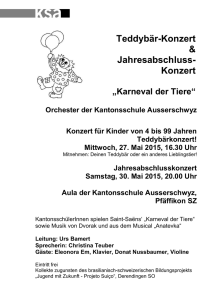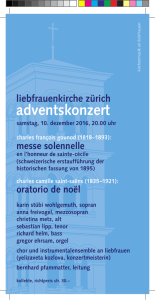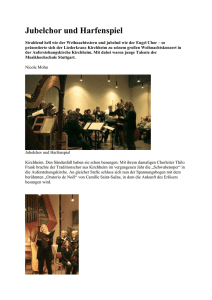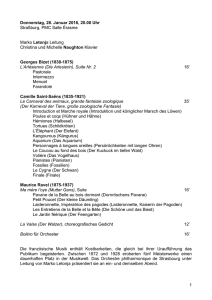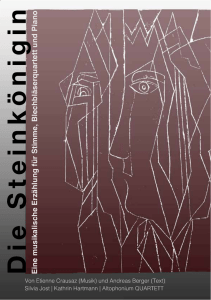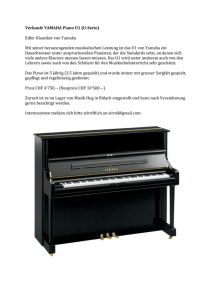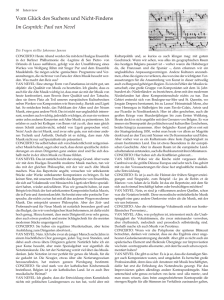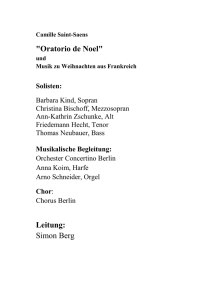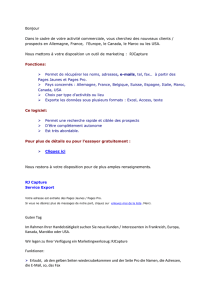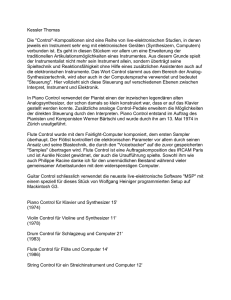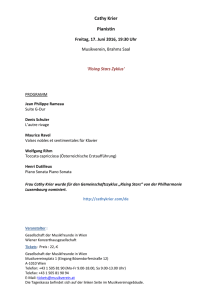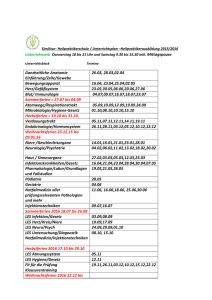Vorwort - G. Henle Verlag
Werbung
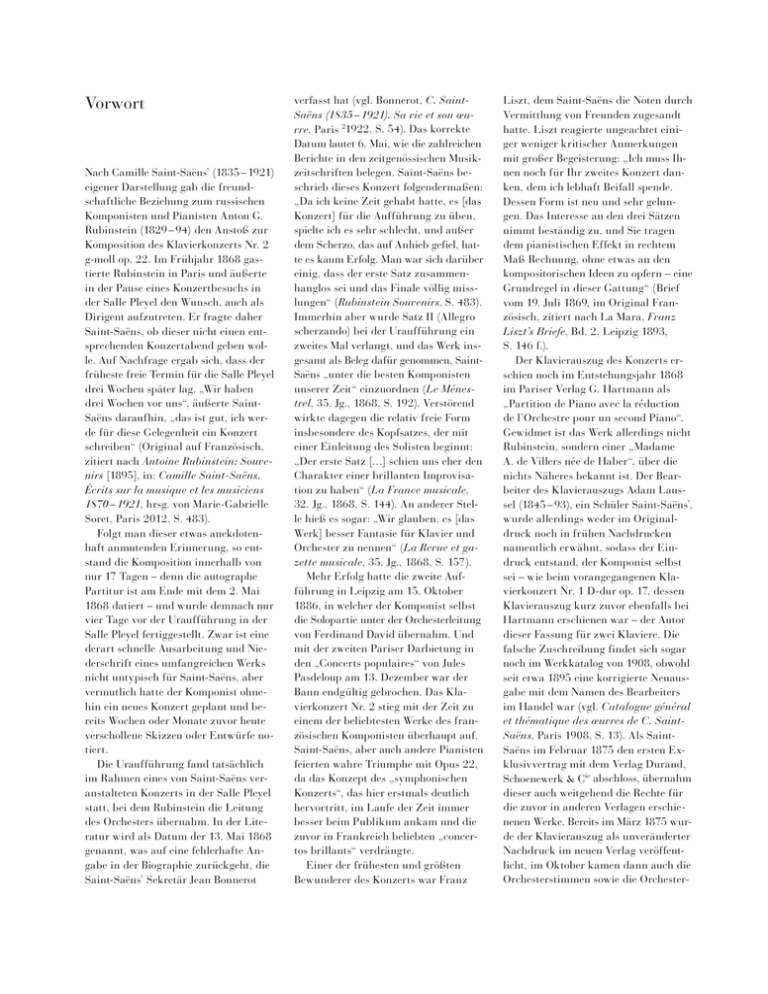
Vorwort Nach Camille Saint-Saëns’ (1835 – 1921) eigener Darstellung gab die freundschaftliche Beziehung zum russischen Komponisten und Pianisten Anton G. Rubinstein (1829 – 94) den Anstoß zur Komposition des Klavierkonzerts Nr. 2 g-moll op. 22. Im Frühjahr 1868 gastierte Rubinstein in Paris und äußerte in der Pause eines Konzertbesuchs in der Salle Pleyel den Wunsch, auch als Dirigent aufzutreten. Er fragte daher Saint-Saëns, ob dieser nicht einen entsprechenden Konzertabend geben wolle. Auf Nachfrage ergab sich, dass der früheste freie Termin für die Salle Pleyel drei Wochen später lag. „Wir haben drei Wochen vor uns“, äußerte SaintSaëns daraufhin, „das ist gut, ich werde für diese Gelegenheit ein Konzert schreiben“ (Original auf Französisch, zitiert nach Antoine Rubinstein: Souvenirs [1895], in: Camille Saint-Saëns. Écrits sur la musique et les musiciens 1870 – 1921, hrsg. von Marie-Gabrielle Soret, Paris 2012, S. 483). Folgt man dieser etwas anekdotenhaft anmutenden Erinnerung, so entstand die Komposition innerhalb von nur 17 Tagen – denn die autographe Partitur ist am Ende mit dem 2. Mai 1868 datiert – und wurde demnach nur vier Tage vor der Uraufführung in der Salle Pleyel fertiggestellt. Zwar ist eine derart schnelle Ausarbeitung und Niederschrift eines umfangreichen Werks nicht untypisch für Saint-Saëns, aber vermutlich hatte der Komponist ohnehin ein neues Konzert geplant und bereits Wochen oder Monate zuvor heute verschollene Skizzen oder Entwürfe notiert. Die Uraufführung fand tatsächlich im Rahmen eines von Saint-Saëns veranstalteten Konzerts in der Salle Pleyel statt, bei dem Rubinstein die Leitung des Orchesters übernahm. In der Literatur wird als Datum der 13. Mai 1868 genannt, was auf eine fehlerhafte Angabe in der Biographie zurückgeht, die Saint-Saëns’ Sekretär Jean Bonnerot verfasst hat (vgl. Bonnerot, C. SaintSaëns (1835 – 1921). Sa vie et son œu­ vre, Paris 21922, S. 54). Das korrekte Datum lautet 6. Mai, wie die zahlreichen Berichte in den zeitgenössischen Musikzeitschriften belegen. Saint-Saëns beschrieb dieses Konzert folgendermaßen: „Da ich keine Zeit gehabt hatte, es [das Konzert] für die Aufführung zu üben, spielte ich es sehr schlecht, und außer dem Scherzo, das auf Anhieb gefiel, hatte es kaum Erfolg. Man war sich darüber einig, dass der erste Satz zusammenhanglos sei und das Finale völlig misslungen“ (Rubinstein Souvenirs, S. 483). Immerhin aber wurde Satz II (Allegro scherzando) bei der Uraufführung ein zweites Mal verlangt, und das Werk insgesamt als Beleg dafür genommen, Saint- Saëns „unter die besten Komponisten unserer Zeit“ einzuordnen (Le Ménes­ trel, 35. Jg., 1868, S. 192). Verstörend wirkte dagegen die relativ freie Form insbesondere des Kopfsatzes, der mit einer Einleitung des Solisten beginnt: „Der erste Satz […] schien uns eher den Charakter einer brillanten Improvisa­ tion zu haben“ (La France musicale, 32. Jg., 1868, S. 144). An anderer Stelle hieß es sogar: „Wir glauben, es [das Werk] besser Fantasie für Klavier und Orchester zu nennen“ (La Revue et gazette musicale, 35. Jg., 1868, S. 157). Mehr Erfolg hatte die zweite Auf­ führung in Leipzig am 15. Oktober 1886, in welcher der Komponist selbst die Solopartie unter der Orchesterleitung von Ferdinand David übernahm. Und mit der zweiten Pariser Darbietung in den „Concerts populaires“ von Jules Pasdeloup am 13. Dezember war der Bann endgültig gebrochen. Das Klavierkonzert Nr. 2 stieg mit der Zeit zu einem der beliebtesten Werke des französischen Komponisten überhaupt auf. Saint-Saëns, aber auch andere Pianisten feierten wahre Triumphe mit Opus 22, da das Konzept des „symphonischen Konzerts“, das hier erstmals deutlich hervortritt, im Laufe der Zeit immer besser beim Publikum ankam und die zuvor in Frankreich beliebten „concertos brillants“ verdrängte. Einer der frühesten und größten Bewunderer des Konzerts war Franz Liszt, dem Saint-Saëns die Noten durch Vermittlung von Freunden zugesandt hatte. Liszt reagierte ungeachtet einiger weniger kritischer Anmerkungen mit großer Begeisterung: „Ich muss Ihnen noch für Ihr zweites Konzert danken, dem ich lebhaft Beifall spende. Dessen Form ist neu und sehr gelungen. Das Interesse an den drei Sätzen nimmt beständig zu, und Sie tragen dem pianistischen Effekt in rechtem Maß Rechnung, ohne etwas an den kompositorischen Ideen zu opfern – eine Grundregel in dieser Gattung“ (Brief vom 19. Juli 1869, im Original Fran­ zösisch, zitiert nach La Mara, Franz Liszt’s Briefe, Bd. 2, Leipzig 1893, S. 146 f.). Der Klavierauszug des Konzerts erschien noch im Entstehungsjahr 1868 im Pariser Verlag G. Hartmann als „Partition de Piano avec la réduction de l’Orchestre pour un second Piano“. Gewidmet ist das Werk allerdings nicht Rubinstein, sondern einer „Madame A. de Villers née de Haber“, über die nichts Näheres bekannt ist. Der Bearbeiter des Klavierauszugs Adam Laussel (1845 – 93), ein Schüler Saint-Saëns’, wurde allerdings weder im Originaldruck noch in frühen Nachdrucken namentlich erwähnt, sodass der Eindruck entstand, der Komponist selbst sei – wie beim vorangegangenen Klavierkonzert Nr. 1 D-dur op. 17, dessen Klavierauszug kurz zuvor ebenfalls bei Hartmann erschienen war – der Autor dieser Fassung für zwei Klaviere. Die falsche Zuschreibung findet sich sogar noch im Werkkatalog von 1908, obwohl seit etwa 1895 eine korrigierte Neuausgabe mit dem Namen des Bearbeiters im Handel war (vgl. Catalogue général et thématique des œuvres de C. SaintSaëns, Paris 1908, S. 13). Als SaintSaëns im Februar 1875 den ersten Exklusivvertrag mit dem Verlag Durand, Schoenewerk & Cie abschloss, übernahm dieser auch weitgehend die Rechte für die zuvor in anderen Verlagen erschienenen Werke. Bereits im März 1875 wurde der Klavierauszug als unveränderter Nachdruck im neuen Verlag veröffentlicht, im Oktober kamen dann auch die Orchesterstimmen sowie die Orchester- III partitur heraus (zu den Quellen und ihrer Bewertung siehe die Bemerkungen am Ende der vorliegenden Edition). Eine Bearbeitung für Klavier solo von Georges Bizet, deren Entstehungszeit unbekannt ist, erschien vollständig erst 1894, das von Anfang an beliebte Allegro scherzando daraus bereits 1876. Allen in den Bemerkungen genannten Bibliotheken sei an dieser Stelle für die freundliche Bereitstellung der Quellenkopien herzlich gedankt. München, Herbst 2016 Peter Jost Preface According to Camille Saint-Saëns’s (1835 – 1921) own account, his amicable relationship with the Russian composer and pianist Anton G. Rubinstein (1829 – 94) provided the impetus for the composition of the Piano Concerto no. 2 in g minor op. 22. In the spring of 1868 Rubinstein gave a guest performance in Paris and, during the interval of a concert at the Salle Pleyel, expressed the desire to also make an appearance as conductor. He therefore asked SaintSaëns whether he [Saint-Saëns] would be interested in giving such a concert. An inquiry confirmed that the earliest free date for the Salle Pleyel was in three weeks’ time. “We have three weeks ahead of us”, commented Saint-Saëns, “this is good, I shall write a concerto for the occasion” (original in French, as cited in Antoine Rubinstein: Souvenirs [1895], in: Camille Saint-Saëns. Écrits sur la musique et les musiciens 1870 – 1921, ed. by Marie-Gabrielle Soret, Paris, 2012, p. 483). If one is to believe this apparently rather anecdotal reminiscence, the Concerto came into being within 17 days – for the autograph score is dated 2 May 1868 at the end – and thus was finished only four days before its première at the Salle Pleyel. Such quick composition and writing down of an extensive work was certainly not untypical of Saint-Saëns, but the com­poser had ­presumably planned a new concerto in any case, and had already notated now-lost sketches and drafts weeks or months beforehand. The première did in fact take place as part of a concert organised by SaintSaëns at the Salle Pleyel, with Rubinstein assuming direction of the orchestra. In the literature the date is given as 13 May 1868, which derives from an error in the biography by Saint-Saëns’s secretary Jean Bonnerot (cf. Bonnerot, C. Saint-Saëns (1835 – 1921). Sa vie et son œuvre, Paris, 21922, p. 54). The correct date is 6 May, as is evidenced by the numerous reports in contemporary musical journals. Saint-Saëns described the concert as follows: “Since I did not have any time to practice it [the Concerto] for the performance, I played it very badly. And except for the Scherzo, which immediately found favour, it was hardly a success. All agreed that the first movement was disjointed and the finale entirely unsuccessful” (Rubinstein Sou­ venirs, p. 483). For all that, the movement II (Allegro scherzando) was demanded a second time at the première, and the work as a whole taken as confirmation that Saint-Saëns ranked “among the best composers of our time” (Le Mé­ nes­trel 35, 1868, p. 192). Disturbing, on the other hand, was the relatively free form, particularly of the opening movement, which begins with a Introduction for the soloist: “The first movement […] seemed to us to have rather the character of a brilliant improvisation” (La France musicale 32, 1868, p. 144). Elsewhere, it was even said: “We believe that it would be better to call it Fantasy for piano and orchestra” (La Revue et gazette musicale 35, 1868, p. 157). The second performance on 15 October 1868 in Leipzig, in which the composer played the solo part under the ­baton of Ferdinand David, had more success. And with the second Parisian performance, at Jules Pasdeloup’s “Concerts populaires” on 13 December, the spell was definitively broken. With time the Piano Concerto no. 2 grew to become one of the French composer’s most popu­ lar works. Saint-Saëns, and other pianists too, celebrated veritable triumphs with op. 22, since the concept of the “sym­phon­ic concerto”, which clearly emerged here for the first time, found in­ creasing acceptance by the public over the course of time and superseded the “concertos bril­lants” previously so popular in France. One of the first and greatest admirers of the Concerto was Franz Liszt, to whom Saint-Saëns had sent the music through the agency of friends. Notwithstanding some mildly critical remarks, Liszt reacted with great enthusiasm: “I want to thank you for your second Concerto, which I applaud energetically. Its form is new and very successful. The interest in the three movements increases steadily, and you take into account the pianistic effect to the proper degree without sacrificing anything of the compositional ideas, which is an essential rule in this genre” (letter of 19 July 1869, original in French, as cited in La Mara, Franz Liszt’s Briefe, vol. 2, Leipzig, 1893, pp. 146 f.) The piano reduction of the Concerto was issued in 1868, the year of its composition, by the Parisian publisher G. Hartmann as “Partition de Piano avec la réduction de l’Orchestre pour un second Piano”. However, the work was not dedicated to Rubinstein, but rather to a “Madame A. de Villers née de Haber”, about whom nothing further is known. Adam Laussel (1845 – 93), a Saint-Saëns’s pupil, produced the piano reduction, but was mentioned by name neither in the original edition nor in the early reprints, giving rise to the impression that the composer himself was the author of this version for two pianos, as had been the case with his preceding Piano Concerto no. 1 in D major op. 17, the piano reduction of which was likewise issued by Hartmann a short time before. The false attribution is even still present in the catalogue of works from 1908, even IV though a corrected new edition with the name of the arranger had been commercially available since around 1895 (cf. Catalogue général et thématique des œu­vres de C. Saint-Saëns, Paris, 1908, p. 13). When in February 1875 SaintSaëns signed his first exclusive contract with publishers Durand, Schoenewerk & Cie, this firm also assumed the rights to most of his works issued previously by other publishers. The piano reduction was released by the new publishers as an unaltered reprint as early as March 1875; the orchestral parts and orchestral score followed in October (concerning the sources and their evaluation, see the Comments at the end of the present edition). An arrangement for piano solo by Georges Bizet, date of origin unknown, was issued complete only in 1894; the Allegro scherzando, which was popular from the start, in 1876. The editor thanks those libraries mentioned in the Comments for kindly providing copies of the sources. Munich, autumn 2016 Peter Jost Préface Selon le propre témoignage de Camille Saint-Saëns (1835 – 1921), son amicale relation avec le compositeur et pianiste russe Anton G. Rubinstein (1829 – 94) fut à l’origine de la composition de son 2e Concerto pour piano en sol mineur op. 22. Rubinstein séjourna au printemps 1868 à Paris et exprima, lors d’une pause au cours d’un concert à la Salle Pleyel, le souhait de se produire également en tant que chef d’orchestre. Aussi demanda-t-il à Saint-Saëns s’il ne voulait pas donner un concert en soirée qui lui permettrait de combler ce souhait. Renseignements pris, il s’avéra que la première date possible pour un tel concert était à l’horizon de trois semaines. «Nous avons trois semaines devant nous» déclara alors Saint-Saëns. «C’est bien, j’écrirai un concerto pour la circonstance» (Antoine Rubinstein: Souvenirs [1895], dans: Camille SaintSaëns. Écrits sur la musique et les musiciens 1870 – 1921, éd. par Marie-Gabrielle Soret, Paris, 2012, p. 483). Si l’on accepte ce souvenir à l’allure quelque peu anecdotique, l’œuvre fut composée en 17 jours à peine – la par­ tition autographe est en effet datée à la fin du 2 mai 1868 – et ne fut donc achevée que quatre jours avant la création à la Salle Pleyel. Il est vrai qu’une élaboration et une copie aussi rapides d’une œuvre importante n’est pas insolite chez Saint-Saëns, mais il est probable que le compositeur avait déjà nourri antérieurement le projet d’un nouveau concerto et élaboré quelques semaines, voire quelques mois aupa­ ravant diverses esquisses aujourd’hui perdues. La création eut lieu en effet dans le cadre d’un concert organisé par SaintSaëns à la Salle Pleyel lors duquel Rubinstein dirigea l’orchestre. Dans la littérature il est toujours question du 13 mai 1868, mais cette date repose sur une indication erronée de la bio­ graphie rédigée par le secrétaire de Saint-Saëns Jean Bonnerot (cf. Bonnerot, C. Saint-Saëns (1835 – 1921). Sa vie et son œuvre, Paris, 21922, p. 54). La date exacte est celle du 6 mai, comme l’attestent de nombreux articles parus dans la presse musicale de l’époque. Saint-Saëns décrivit ce concert en ces termes: «N’ayant pas eu le temps de le [le Con­cer­to] travailler au point de vue de l’exé­cution, je le jouais fort mal, et sauf le scherzo, qui plut du premier coup, il réussit peu; on s’accorda à trouver la première partie incohérente et le finale tout à fait manqué» (Rubinstein Souvenirs, p. 483). Quoiqu’il en soit, le mouvement II (Allegro scherzando) fut bissé lors de la création, et l’œuvre ellemême attestait qu’il convenait désormais de «ranger M. Saint-Saëns parmi les meilleurs compositeurs de notre temps» (Le Ménestrel, 35e année, 1868, p. 192). En revanche, la forme relativement libre du mouvement I, qui commence sur une cadence du soliste, troubla les auditeurs: «Le premier morceau […] nous paraît plutôt avoir le caractère d’une brillante improvisation» (La France musicale, 32e année, 1868, p. 144). Ailleurs, il est même dit qu’il s’agit d’une œuvre «que nous croirions plus juste d’appeler Fantaisie pour piano et orchestre» (La Revue et gazette musicale, 35e année, 1868, p. 157). La deuxième audition, à Leipzig le 15 octobre 1868, connut un plus vif succès. Le compositeur exécuta lui-même la partie de soliste et la direction fut as­ surée par Ferdinand David. Et avec la deuxième audition parisienne, le 13 décembre, dans le cadre des «Con­certs populaires» de Jules Pasdeloup, le sor­ tilège fut définitivement rompu. Au fil du temps, le Concerto pour piano no 2 devint l’une des œuvres les plus appréciées du compositeur français. SaintSaëns, mais aussi d’autres pianistes, connurent de véritables triomphes avec l’opus 22, car le concept du «concert symphonique» qui apparaît ici nettement pour la première fois, devait dé­ finitivement supplanter les «concertos brillants» jusqu’alors si prisés par le public français. L’un des premiers et des plus grands admirateurs du Concerto fut Franz Liszt auquel Saint-Saëns avait fait parvenir la musique par l’intermédiaire d’amis. Mis à part quelques légères observations critiques, Liszt manifesta un grand enthousiasme: «Je viens vous remercier encore de votre deuxième Concerto que j’applaudis vivement. La forme en est neuve et très heureuse; l’in­ térêt des trois morceaux va croissant, et vous tenez un juste compte de l’effet du pianiste sans rien sacrifier des idées du compositeur, règle essentielle dans ce genre d’ouvrage» (lettre du 19 juillet 1869, citée d’après La Mara, Franz Liszt’s Briefe, vol. 2, Leipzig, 1893, pp. 146 s.). La réduction pour piano du Concerto parut encore en 1868, l’année de la création, chez l’éditeur parisien G. Hartmann en tant que «Partition de Piano avec la réduction de l’Orches­ V tre pour un second Piano». L’œuvre n’est cependant pas dédiée à Rubin­ stein, mais à une «Madame A. de Villers née de Haber» dont on ne sait rien de plus. Adam Laussel (1845 – 93), l’auteur de la réduction pour piano et élève de Saint-Saëns, ne fut toutefois cité nommément ni dans l’édition originale ni dans les premières réimpressions, de sorte qu’il se dégagea l’impres­ sion que le compositeur avait été luimême l’auteur de cette version pour deux pianos, comme il l’avait été pour le précédent Concerto pour piano no 1 en Ré majeur op. 17, paru peu avant égale­ ment chez Hartmann. La fausse attribution se retrouve encore dans le catalogue des œu­v res de Saint-Saëns de 1908, bien que dès 1895 environ, une nouvelle édition corrigée portant le nom de l’arrangeur été commercialisée (cf. Catalogue ­général et thématique des œu­vres de C. Saint-Saëns, Paris, 1908, p. 13). Lorsqu’en février 1875 Saint-Saëns signa le premier contrat d’ex­ clusivité avec la maison d’édition Durand, Schoenewerk & Cie, cette dernière reprit également assez largement les droits pour les œu­v res parues auparavant chez les autres éditeurs. Dès le mois de mars 1875 la réduction pour piano parut sous la forme d’une réimpression à l’identique chez le nouvel éditeur qui publia ensuite en octobre les parties séparées ainsi que la partition d’orches­t re (pour les sources et leur évaluation voir les Bemerkungen ou Comments à la fin de la présente édition). Un arrangement pour piano solo par Georges Bizet, dont la date de composition est inconnue, ne parut dans son intégralité qu’en 1894, alors que l’Allegro scherzando, qui fut immédiatement si populaire, parut dès 1876. Nous remercions toutes les bibliothè­ ques citées dans les Bemerkungen ou Comments d’avoir aimablement mis à notre disposition les copies des sour­ ces. Munich, automne 2016 Peter Jost Abkürzungen · Abbreviations · Abréviations Bl. Fg. Fl. Holzbl. Hrn. Kb. Klar. Ob. Pk. Str. Trp. Va. Vc. Vl. Bläser / winds / vents Fagott / bassoon / basson Flöte / flute / flûte Holzbläser / woodwinds / bois Horn / cor Kontrabass / double bass / contrebasse Klarinette / clarinet / clarinette Oboe / hautbois Pauke / timpani / timbales Streicher / strings / cordes Trompete / trumpet / trompette Viola / alto Violoncello / violoncelle Violine / violin / violon
